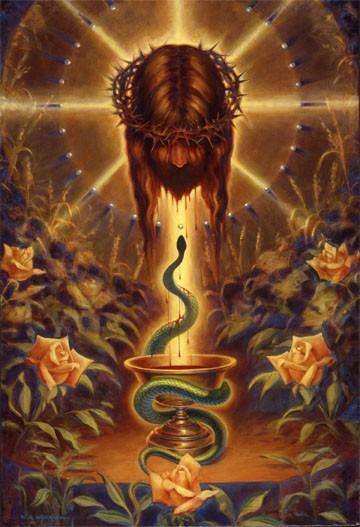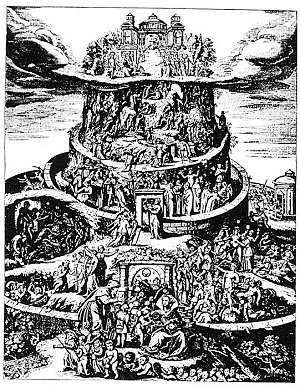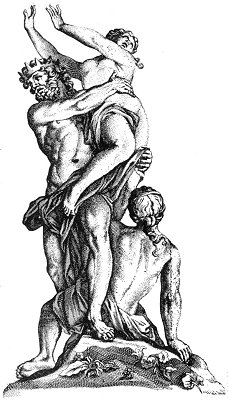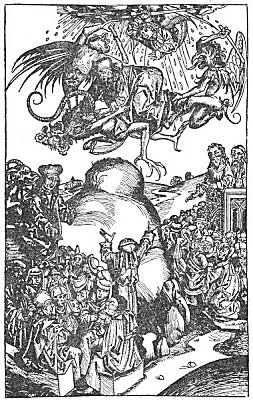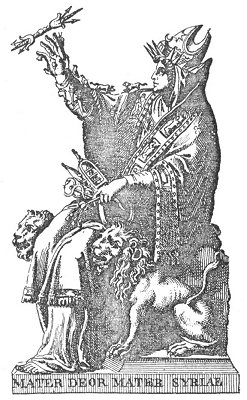“The seven impostor-Daemons who deceive the sons of Adam. The name of one is Sol; of another Spiritus Venereus, Astro; of the third Nebu, Mercurius a false Messiah; . . . the name of a fourth is Sin Luna; the fifth is Kiun, Saturnus; the sixth, Bel-Zeus; the seventh, Nerig-Mars.“Then there are “Seven Lives procreated,” seven good Stellars, “which are from Cabar Zio, and are those bright ones who shine in their own form and splendor that pours from on high. . . . At the gate of the HOUSE OF LIFE the throne is fitly placed for the Lord of Splendor, and there are THREE habitations.” The habitations of the Trimurti, the Hindu trinity, are placed beneath the key-stone — the golden crescent, in the representation of Meru. “And there was under his feet (of the God of Israel) as it were a paved work of a sapphire-stone” (Exodus xxiv. 10). Under the crescent is the heaven of Brahma, all paved with sapphires. The paradise of Indra is resplendent with a thousand suns; that of Siva (Saturn), is in the northeast; his throne is formed of lapis-lazuli and the floor of heaven is of fervid gold. “When he sits on the throne he blazes with fire up to the loins.” At Hurdwar, during the fair, in which he is more than ever Mahadeva, the highest god, the attributes and emblems sacred to the Jewish “Lord God,” may be recognized one by one in those of Siva. The Binlang stone, sacred to this Hindu deity, is an unhewn stone like the Beth-el, consecrated by the Patriarch Jacob, and set up by him “for a pillar,” and like the latter
Page 235
Binlang is anointed. We need hardly remind the student that the linga, the emblem sacred to Siva and whose temples are modelled after this form, is identical in shape, meaning, and purpose with the “pillars” set up by the several patriarchs to mark their adoration of the Lord God. In fact, one of these patriarchal lithoi might even now be carried in the Sivaitic processions of Calcutta, without its Hebrew derivation being suspected. The four arms of Siva are often represented with appendages like wings; he has three eyes and a fourth in the crescent, obtained by him at the churning of the ocean, as Pancha Mukhti Siva has four heads.
In this god we recognize the description given by Ezekiel, in the first chapter of his book, of his vision, in which he beholds the “likeness of a man” in the four living creatures, who had “four faces, four wings,” who had one pair of “straight feet . . . which sparkled like the color of burnished brass . . . and their rings were full of eyes round about them four.” It is the throne and heaven of Siva that the prophet describes in saying ” . . . and there was the likeness of a throne as the appearance of a sapphire stone . . . and I saw as the color of amber (gold) as the appearance of fire around about . . . from his loins even upward, and from the appearance of his loins even downward, I saw as it were the appearance of fire” (Ezekiel i. 27). “And his feet like unto fine brass, as if they burned in a furnace” (Revelation i. 15). “As for their faces . . . one had the face of a cherub, and the face of a lion . . . they also had the face of an ox and the face of an eagle” (Ezekiel i. 10, x. 14). This fourfold appearance which we find in the two cherubims of gold on the two ends of the ark; these symbolic four faces being adopted, moreover, later, one by each evangelist, as may be easily ascertained from the pictures of Matthew, Mark, Luke, and John, prefixed to their respective gospels in the Roman Vulgate and Greek Bibles.
“Taaut, the great god of the Phoenicians,” says Sanchoniathon, “to express the character of Saturn or Kronos, made his image having four eyes . . . two before, two behind, open and closed, and four wings, two expanded, two folded. The eyes denote that the god sees in sleep, and sleeps in waking; the position of the wings that he flies in rest, and rests in flying.”

Moe is the founder of GnosticWarrior.com. He is a father, husband, author, martial arts black belt, and an expert in Gnosticism, the occult, and esotericism.

